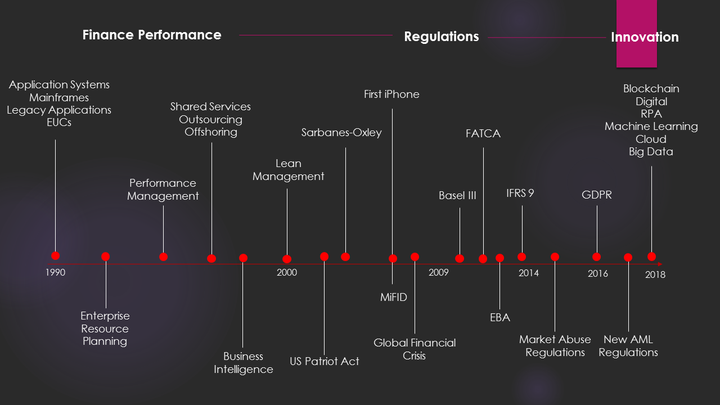In the 90’s, we talked about Enterprise Resource Planning (ERP), an integrated BPM software that was designed and built to centralize the management of frontend and backend business functions such as SRM, PLM, SCM, CRM, HCM and Accounting, etc…

Companies were eager to implement ERPs to replace or consolidate their distributed/fragmented application landscape and end user computing tools to gain efficiency and effectiveness in managing their operations. It was the trendy thing to do at that time, and automation was already a hot topic for most of the organizations. Namely, SAP, Oracle, BaaN, Sun Systems, JDE and Lawson were competing in the market. On top of the ERPs, applications such as Cognos, Comshare FDC, Hyperion and Cartesis were broadly in use to manage planning, reporting and consolidation activities. For MIS requirements, we could go for Crystal Reports, Qlik, MicroStrategy or Business Objects.
While implementing ERPs and other associated applications, companies also initiated a cycle of process streamlining and lean management. So, transformations such as F&A shared service center implementations, outsourcing and offshoring coupled with Kaizen and Six Sigma emerged in support of the system implementations.
Clearly, from 1990 to 2000, Enterprise Finance and Performance Management took a predominant space in transformations. In Europe, firms also went through adoption of the Euro currency and the International Accounting Standards (IAS) which were complex journeys too.
From 2001 to 2002, the collapse of large corporations such as Enron, WorldCom and Arthur Andersen and the 9/11 terrorist attack pushed governmental bodies to issue a whole bunch of regulatory and compliance obligations to prevent/detect financial crimes (US Patriot Act) and to provide stronger internal control over preparation and disclosure of financial statements (Sarbanes-Oxley Act) to protect investors from the possibility of fraudulent activities by corporations.
To amplify the migraine of C-Level Executives largely involved in a massive number of projects, financial scandals such as Lehman Brothers and Madoff leading to the credit crunch crisis in 2008 increased the number of market abuse regulations across all continents. SEC, FINMA, FINRA, FinCEN and many others revisited their directives and released a big chunk of new regulations specifically oriented towards financial services.
Evidently, from 2002 to 2010, corporations enhanced their Enterprise Risk and Compliance functions to comply with the never stopping regulatory requirements as opposed to drive continuous improvements. Since 2010 and with the considerable increase in digitization and Big Data, financial services are almost swimming in a large pool of regulations and the list is very long, but namely we talk about MAD/MAR, FATCA, CRS, Dodd-Frank, BCBS 239, Basel 3, CTF, IFRS 9, 16 and 17, Solvency, MiFID, FinRep, CoRep, AnaCredit, etc… and the mood continues with GDPR and others to follow.
Looking back in time and seeing the trends in today’s market, the traditional finance transformation of 30 years ago has completely changed its face and evolved from a purely enhancement of the CFO function to a broader journey including risk, compliance and operating model initiatives. Today, companies struggle because much of the tactical technology currently in place was not designed to adapt and excel in the era of digital disruption, cloud computing, machine learning, AI, and at the same time, comply with an ocean of regulations.
Within many organizations, transformations were planned and executed without a consistent strategic visioning and alignment with a target operating model. C-Level Executives were so much under pressure to deliver quick stop gap solutions over the last years that they had no time and bandwidth to come up with a compelling strategic business model given the uncertainty and volatility of the market and regulations. The major headache of C-Level Executives of today is to reformulate a long-term strategy and to redesign both IT and Business architectures considering data analytics and on-going changes in technology and regulations. Placebo effect does not last long and is very costly. The best way to start a transformation is to elaborate a compelling and consistent transformation strategy and strategic roadmap before embarking the organization in a long journey.
Today’s finance transformation is simply a convoluted word which includes many objectives that could become misleading and difficult to understand.
The Next Generation Risk and Finance Transformation is about delivering growth and managing complexity while sustaining a vision and complying with regulations and emphasizing in getting the most valuable insights from the digital assets.

Finance Transformation is not only a CFO agenda. It requires heavy and ongoing sponsorship from the CIOs, CSOs, CDOs, CCOs and CROs. They must jointly streamline their thinking and achieve some key imperatives:
1. Aligning the strategy at all levels to ensure the best in class execution of the transformation
2. Maintaining and updating the enterprise operating models (ITOM and BOM)
3. Identify transformation’s KPIs to Monitor business performance
4. Produce a compelling digital transformation strategy and execution plan
5. Develop advanced business capabilities across all functions
6. Invest in innovations, hire a Chief Innovation Officer and launch a team in charge of constantly monitoring emerging technologies to support updates of the business strategies and operating models
7. Building a single source of truth via data lakes coupled with a robust enterprise data governance model
Going forward, organizations must put in place flexible and scalable technology platforms while complying with regulations and managing their petabytes of data.
Deploying technologies to only tick a compliance box is not a sustainable strategy and rework of the solutions can be drastically costly and risky in today’s business context.
The CFOs are under the gun as they have the difficult challenge of managing the exponential growth of regulatory controls while focusing on performance of their business. The Digital and Innovation journeys are heavily Data Centric and having a single and centralized data lake playing the “Data as a service” role would be the best way to capture, integrate, easily access, and analyze high-quality data before serving Risk, Finance and Compliance functions.
About the Author
Julien Mansourian (www.linkedin.com/in/julienmansourian) is currently a Senior Director of Professional Services at Oracle. Across his long career in Finance and Consulting, he was involved in heavy and large scale business and finance transformations within multiple sectors and corporations worldwide. In his role at Oracle, he provides strategy and transformation services to Banking sector across Europe, the Middle East and Africa. His focus resides in Risk, Finance and Performance journeys coupled with integration of data and behaviour analytics supporting clients in their digital planning and execution.
